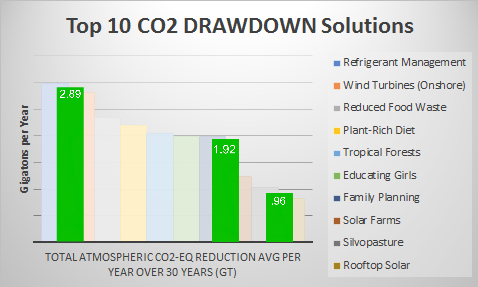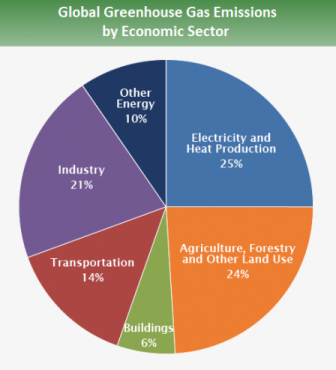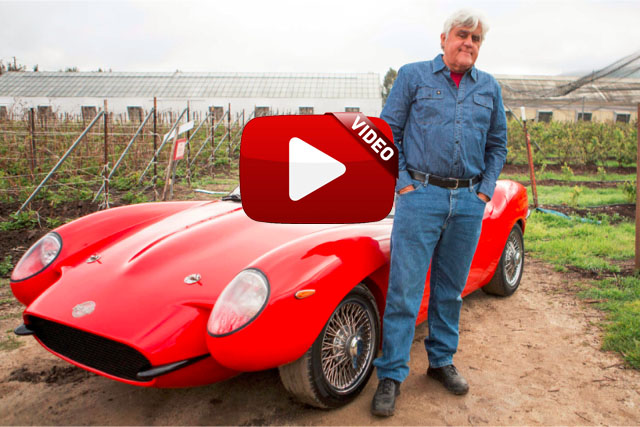 If you’re like me, you’re tired of hearing about the upcoming climate catastrophe. We already know the threat is real. So all we really want to hear about now are solutions. And they had better be good ones because we only have 12 years left to figure this out.
If you’re like me, you’re tired of hearing about the upcoming climate catastrophe. We already know the threat is real. So all we really want to hear about now are solutions. And they had better be good ones because we only have 12 years left to figure this out.
That’s why it came as a shock to me (of all people, who designed a car made of hemp wherever possible, and fueled by agricultural waste) while reading the best seller Drawdown that Electric Vehicles aren’t expected to make all that much of an impact on climate change between 2020 and 2050!
In fact, the best-selling book only expects EVs to “draw down” an average of .36 billion metric tons or “gigatons” of CO2 per year during this period. That’s only about 1% of the 40 GT of CO2 we humans currently dump into the atmosphere every year. Don’t get me wrong. I love electric vehicles. But according to Drawdown, EV’s aren’t even on the “Top Ten” list!


According to Drawdown, the top ten things we could be doing to avert climate catastrophe are depicted in the first chart above. But it’s the second chart that’s going to blow your mind. According to research from multiple sources, making everything we can from plant materials could either be the 10th, 8th or perhaps even the #1 most effective way to mitigate a climate catastrophe. It all depends upon how serious we take up the challenge.
If only 5% of everything made were made from plants, we would be drawing down 3X more CO2 than electric vehicles! At 10%, the draw down would approach 2 gigatons per year. But if we were to make a mere 15% of what we need from plants, we could draw down nearly 3 gigatons per year.
But how might this be possible? The first answer is that we recognize that humans have lived on this planet without effecting the climate until a hundred years ago. So part one of the answer is to stop doing what we have foolishly done for the last 100 years. We cannot continue to make stuff from materials that require massive amounts of fossil fuels to produce. Part two of the answer involves two measures of Carbon Sequestration and one measure of Carbon Avoidance. This is the recipe for fixing what we have already messed up.
CARBON SEQUESTRATION VIA MANUFACTURING
Carbon Sequestration is the process of removing CO2 from the atmosphere and storing it away for an extended period of time. Plants remove CO2 out of the atmosphere via photosynthesis, using free solar energy. By making what we need from plants, we lock up the carbon in plant material (which is derived from atmospheric CO2) into raw materials and products which can then be recycled. So how much CO2 are we talking about sequestering into raw materials and products you ask? For those of you who like math, here is your answer.
Dried plant material is 45% Carbon. So every ton of dried plant material used to manufacture something contains .45 tons of Carbon. Every atom of that Carbon has an atomic weight of 12 and originally came from a molecule of atmospheric CO2 with an atomic weight of 44. To determine how much CO2 was removed from the atmosphere to make that carbon we divide 44 by 12 and then multiply that result by .45. So every ton of dried plant material used to manufacture something sequesters up to 1.65 tons of CO2.
Watch Jay Leno drive the modern day hemp car
Simple enough right?!? Perhaps not. So let’s take a look at a real world example.
The body of our Renew Sports Car weighs 100 pounds. But because it is made from Carbon Negative Fiber (hemp and bio-epoxy), it sequesters 165 pounds of CO2.
CARBON SEQUESTRATION VIA CARBON FARMING
Roughly 20% of the carbon within a plant resides in its roots. So if the roots of the plants grown to make manufacturing feed stock are left “in situ,” or in the soil after being harvested; all that extra carbon which was originally pulled out of the atmosphere is sequestered back into the soil.
CARBON AVOIDANCE

All materials have a manufacturing carbon footprint, otherwise referred to as embedded CO2. Some have much higher footprints than others due to the massive amounts of fossil fuels required to produce them.
 Currently, Fiberglass, aluminum and especially carbon fiber are increasingly being used to replace heavier materials like steel, on the assumption that “lighter is always better.” But lighter isn’t always better.
Currently, Fiberglass, aluminum and especially carbon fiber are increasingly being used to replace heavier materials like steel, on the assumption that “lighter is always better.” But lighter isn’t always better.
As an example, the rear clip of our Renew Sports Car weighs a scant 21.3 pounds and conservatively sequesters about the same measure of CO2. We could have shaved off another 2 pounds in physical weight by making it with Carbon Fiber, but that would have dumped 375 pounds of CO2 into the atmosphere.

Watch a Time Lapse Video Unveiling of a super light Carbon Negative Fiber Body Panel
The net difference? 400 pounds less CO2 in the atmosphere…just from one body panel!
 THE CARBON NEGATIVE BOOM TO COME
THE CARBON NEGATIVE BOOM TO COME
Currently, the Industrial Sector, by burning such huge volumes of fossil fuels is responsible for 21% of all man made Greenhouse Gasses. But within a decade, or at the most two, they will become heros when it comes to saving the planet. And they will help save the planet… with a little help from government… because we as a species have no other choice than to become a Carbon Negative Society. In other words, making everything we can from plants isn’t just a great idea, it’s an inevitable path we will have to pursue in order to survive. And governments around the globe will have no other choice than to make sure this happens.
Such governmental action is not without precedent. Most everyone is familiar with the tax credits doled out to bolster the solar energy, wind energy and electric vehicle industries. All paid off handsomely. Currently there is a bill working its way through Congress to give significant tax credits to manufacturers of plant based chemicals used to make Carbon Negative plastics. When it passes, carbon negative bio-based plastics will be as cheap to produce as petroleum based plastics. And that’s just the beginning. More and more steel, aluminum, fiberglass and carbon fiber will be replaced by Carbon Negative Fiber. More and more cement will be replaced by Hempcrete. Carbon Tax incentives will arise to support all of these industries.
As further proof of inevitability, Carbon Negative Fiber is already less expensive than Carbon Fiber and only marginally more expensive than fiberglass. And with the recent passing of the Farm Bill, Hemp, the most versatile crop on the planet will be grown coast to coast driving the price down further as it used in all sorts of raw materials and products.

All of this is adding up to the inevitable Carbon Negative Boom to Come. Your homes, cars, plastics, furniture and even your clothing will be made from Carbon Negative plants like Hemp.
Are you ready for it?
About the author:
Bruce Michael Dietzen is the founder of CarbonNegative.Technology and the designer and builder of the Renew Sports Car which is the first car made of hemp in the USA since 1941. He can be contacted at brucedietzen@yahoo.com


Bruce – this is an astonishingly-good article – which I will be passing around, of course! Well written, and well done!!